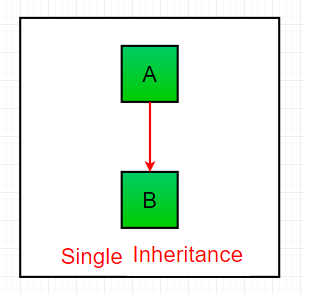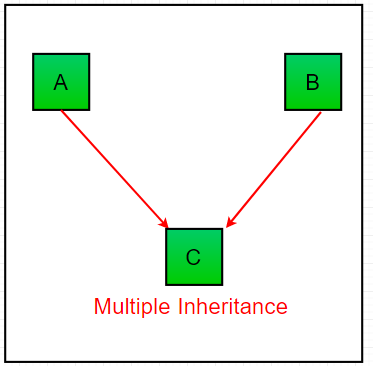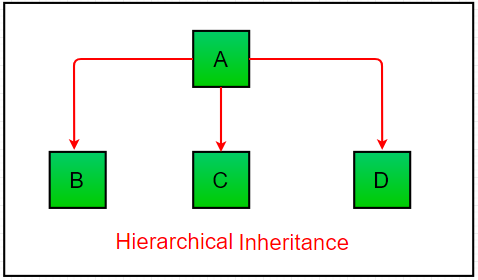Python的继承类型
继承被定义为一个类从其他类派生或继承属性并在需要时使用它的能力。继承提供以下属性:
- 它很好地代表了现实世界的关系。
- 它提供了代码的可重用性。我们不必一次又一次地编写相同的代码。此外,它允许我们在不修改类的情况下向类添加更多功能。
- 它本质上是传递性的,这意味着如果类 B 继承自另一个类 A,那么 B 的所有子类将自动继承自类 A。
例子:
Python3
# A Python program to demonstrate
# inheritance
# Base class or Parent class
class Child:
# Constructor
def __init__(self, name):
self.name = name
# To get name
def getName(self):
return self.name
# To check if this person is student
def isStudent(self):
return False
# Derived class or Child class
class Student(Child):
# True is returned
def isStudent(self):
return True
# Driver code
# An Object of Child
std = Child("Ram")
print(std.getName(), std.isStudent())
# An Object of Student
std = Student("Shivam")
print(std.getName(), std.isStudent())Python3
# Python program to demonstrate
# single inheritance
# Base class
class Parent:
def func1(self):
print("This function is in parent class.")
# Derived class
class Child(Parent):
def func2(self):
print("This function is in child class.")
# Driver's code
object = Child()
object.func1()
object.func2()Python3
# Python program to demonstrate
# multiple inheritance
# Base class1
class Mother:
mothername = ""
def mother(self):
print(self.mothername)
# Base class2
class Father:
fathername = ""
def father(self):
print(self.fathername)
# Derived class
class Son(Mother, Father):
def parents(self):
print("Father :", self.fathername)
print("Mother :", self.mothername)
# Driver's code
s1 = Son()
s1.fathername = "RAM"
s1.mothername = "SITA"
s1.parents()Python3
# Python program to demonstrate
# multilevel inheritance
# Base class
class Grandfather:
def __init__(self, grandfathername):
self.grandfathername = grandfathername
# Intermediate class
class Father(Grandfather):
def __init__(self, fathername, grandfathername):
self.fathername = fathername
# invoking constructor of Grandfather class
Grandfather.__init__(self, grandfathername)
# Derived class
class Son(Father):
def __init__(self,sonname, fathername, grandfathername):
self.sonname = sonname
# invoking constructor of Father class
Father.__init__(self, fathername, grandfathername)
def print_name(self):
print('Grandfather name :', self.grandfathername)
print("Father name :", self.fathername)
print("Son name :", self.sonname)
# Driver code
s1 = Son('Prince', 'Rampal', 'Lal mani')
print(s1.grandfathername)
s1.print_name()Python3
# Python program to demonstrate
# Hierarchical inheritance
# Base class
class Parent:
def func1(self):
print("This function is in parent class.")
# Derived class1
class Child1(Parent):
def func2(self):
print("This function is in child 1.")
# Derivied class2
class Child2(Parent):
def func3(self):
print("This function is in child 2.")
# Driver's code
object1 = Child1()
object2 = Child2()
object1.func1()
object1.func2()
object2.func1()
object2.func3()Python3
# Python program to demonstrate
# hybrid inheritance
class School:
def func1(self):
print("This function is in school.")
class Student1(School):
def func2(self):
print("This function is in student 1. ")
class Student2(School):
def func3(self):
print("This function is in student 2.")
class Student3(Student1, School):
def func4(self):
print("This function is in student 3.")
# Driver's code
object = Student3()
object.func1()
object.func2()输出:
Ram False
Shivam True
Python中的继承类型
继承类型取决于所涉及的子类和父类的数量。 Python中有四种继承类型:
单一继承:单一继承使派生类能够从单个父类继承属性,从而实现代码可重用性和向现有代码添加新功能。

例子:
Python3
# Python program to demonstrate
# single inheritance
# Base class
class Parent:
def func1(self):
print("This function is in parent class.")
# Derived class
class Child(Parent):
def func2(self):
print("This function is in child class.")
# Driver's code
object = Child()
object.func1()
object.func2()
输出:
This function is in parent class.
This function is in child class.
多重继承:当一个类可以从多个基类派生时,这种类型的继承称为多重继承。在多重继承中,基类的所有特性都被继承到派生类中。

例子:
Python3
# Python program to demonstrate
# multiple inheritance
# Base class1
class Mother:
mothername = ""
def mother(self):
print(self.mothername)
# Base class2
class Father:
fathername = ""
def father(self):
print(self.fathername)
# Derived class
class Son(Mother, Father):
def parents(self):
print("Father :", self.fathername)
print("Mother :", self.mothername)
# Driver's code
s1 = Son()
s1.fathername = "RAM"
s1.mothername = "SITA"
s1.parents()
输出:
Father : RAM
Mother : SITA
多级继承
在多级继承中,基类和派生类的特性被进一步继承到新的派生类中。这类似于代表孩子和祖父的关系。

例子:
Python3
# Python program to demonstrate
# multilevel inheritance
# Base class
class Grandfather:
def __init__(self, grandfathername):
self.grandfathername = grandfathername
# Intermediate class
class Father(Grandfather):
def __init__(self, fathername, grandfathername):
self.fathername = fathername
# invoking constructor of Grandfather class
Grandfather.__init__(self, grandfathername)
# Derived class
class Son(Father):
def __init__(self,sonname, fathername, grandfathername):
self.sonname = sonname
# invoking constructor of Father class
Father.__init__(self, fathername, grandfathername)
def print_name(self):
print('Grandfather name :', self.grandfathername)
print("Father name :", self.fathername)
print("Son name :", self.sonname)
# Driver code
s1 = Son('Prince', 'Rampal', 'Lal mani')
print(s1.grandfathername)
s1.print_name()
输出:
Lal mani
Grandfather name : Lal mani
Father name : Rampal
Son name : Prince
层次继承:当从一个基类创建多个派生类时,这种类型的继承称为层次继承。在这个程序中,我们有一个父(基)类和两个子(派生)类。

例子:
Python3
# Python program to demonstrate
# Hierarchical inheritance
# Base class
class Parent:
def func1(self):
print("This function is in parent class.")
# Derived class1
class Child1(Parent):
def func2(self):
print("This function is in child 1.")
# Derivied class2
class Child2(Parent):
def func3(self):
print("This function is in child 2.")
# Driver's code
object1 = Child1()
object2 = Child2()
object1.func1()
object1.func2()
object2.func1()
object2.func3()
输出:
This function is in parent class.
This function is in child 1.
This function is in parent class.
This function is in child 2.
混合继承:由多种继承类型组成的继承称为混合继承。
例子:
Python3
# Python program to demonstrate
# hybrid inheritance
class School:
def func1(self):
print("This function is in school.")
class Student1(School):
def func2(self):
print("This function is in student 1. ")
class Student2(School):
def func3(self):
print("This function is in student 2.")
class Student3(Student1, School):
def func4(self):
print("This function is in student 3.")
# Driver's code
object = Student3()
object.func1()
object.func2()
输出:
This function is in school.
This function is in student 1.